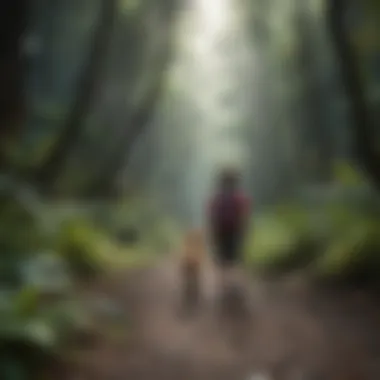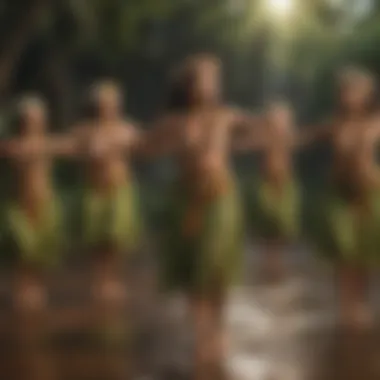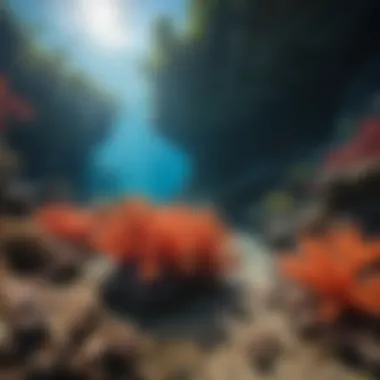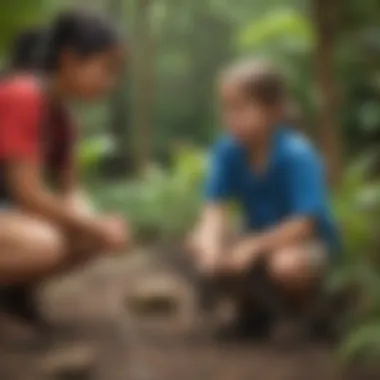Engaging Kids' Activities in Hawaii: Nature and Fun


Intro
Hawaii is an exceptional place, brimming with opportunities for young adventure seekers. Rich in natural beauty, culture, and tradition, the islands provide a playground for curiosity and exploration. Understanding the unique landscape and community in Hawaii can offer a wealth of experiences tailored for children. This section serves as a foundation for exploring various engaging activities geared towards youngsters.
While many associate Hawaii with serene beach days, it’s time to delve deeper. This exploration will highlight outdoor adventures, cultural learning, and ways children can connect with nature while discovering the Hawaiian way of life. Each activity emphasizes enjoyment while also encompassing essential ecological lessons, ensuring children leave enriched by their time spent in this vibrant setting.
Fun Facts About Hawaii
For eager young minds, a few fun facts can spark interest:
- Hawaii is the only state that grows coffee, particularly the renowned Kona coffee.
- The Hawaiian Islands were formed by underwater volcanic activity, meaning plenty of exploration opportunities for curious kids.
- It is home to the magnificent humpback whales that migrate to its warm waters every year.
These facts offer insights and pave a way to learning more about Hawaii’s distinct qualities. Consider incorporating visuals and interactive experiences during activities, making information more digestible for a younger audience.
Wildlife Explorations
Hawaii's ecosystems are known for their unique wildlife. Children can learn about various species native to the islands, like the Hawaiian monk seal and the colorful Hawaiian honeycreeper bird. Key points include:
- Hawaiian monk seal: An endangered species that sunbathes on the beach.
- Humpback whales: They can be seen migrating from November to May, another fascinating sight.
- Native plants: Such as the ʻōhiʻa lehua tree, vital for Hawaiian culture and ecology.
Having interactive features during their learning journey can enhance understanding. Quizzes engaging with the facts about animals and plants may work well.
Environmental Awareness
Hawaii's natural beauty must be cherished. Teaching children about conservation measures is critical:
- Protect the shoreline: Help prevent littering around beaches and parks.
- Raise awareness: Teach kids about native species and their habitats.
- Involve them: Activities focusing on planting trees or beach clean-ups can foster responsibility and connection to nature.
Understanding the practices needed to safeguard these habitats plays a vital role in creating a sustainable future.
DIY Nature Activities
Hands-on activities promote learning through creativity and play. Here are some examples:
Recommended Activities:
- Leaf Rubbing: Collect leaves from Hawaiian plants and make imprints onto paper.
- Nature Collages: Children can collect natural objects like flowers, leaves, or seashells to create fun art.
- Water Testing: Simple experiments can promote environmental awareness.
- Gather leaves of various shapes.
- Place them under the paper.
- Rub a crayon over the paper to reveal leaf patterns.
- Find items around the local beach or parks.
- Organize them in any design you like.
- Glue onto paper to make a unique piece.
- Use clear containers to test the water from different sources (rivers, ponds).
- Observe clarity, and analyze help on which waters better support local wildlife.
Engaging with these activities can yield essential insights into the environment surrounding them. They not only entertain but encourage curiosity in young individuals, further expressing their love for Hawaii's natural wonders.
By diving into these layered activities found in Hawaii, the journey towards greater ecological understanding begins. Each moment spent in nature offers ample opportunities for growth—ensuring future generations respect and honor this unique environment.
Outdoor Adventures
Outdoor adventures in Hawaii play a critical role in offering children the chance to experience nature's beauty firsthand. Exploring the islands' unique landscapes enhances physical health and promotes mental well-being. Engaging in outdoor activities provides kids with opportunities to learn about the environment, wildlife, and cultural significance, fostering curiosity and respect for nature. This section will explore activities to consider that combine fun with learning, worthwhile for both children and their guardians.
Hiking Trails for Families
Hiking trails in Hawaii offer various experiences for families. Trails range from easy walks to more challenging paths suited for older children. The diverse ecosystems ensure that each hike can be a learning experience. On the Hawaiian trails, families can spot unique flora and fauna while enjoying beautiful scenic views.
Well-known hikes include the Diamond Head Crater Trail on Oahu, which offers panoramic views of Waikiki. It’s a moderately easy hike that welcomes families with young children. Meanwhile, the Waimea Canyon Trail, while more challenging, presents another aspect of Hawaii’s geography to explore.


Taking time for active outdoor adventures like hiking nurtures health, strengthens family bonds, and inspires awe of Hawaii’s geography.
Beach Activities
Beach activities give a variable ways to enjoy the water while developing skills. The swimming, splashing, and games allow children to spend energetic hours under the sun, facilitating a satisfying mix of play and education.
Snorkeling Adventures
Snorkeling provides a unique window into underwater life. Children can witness colorful fish and coral reefs without extensive training. Snorkeling profound impact on them, as it raises awareness for ocean conservation. Hawaii's clear waters, especially near Hanauma Bay, make it a popular choice. Safety is a concern for parents, therefore, ensuring kids understand the basics of snorkeling will promote their comfort.
Don’t forget to encourage responsible enjoyment by respecting marine life during the encounters.
Surfing Lessons
Surfing lessons can engage children in water sports activities. Learning to ride the waves is not just a physical endeavor; it also teaches patience and perseverance. Places like Waikiki are known for suitable waves for beginners. Gliding on water helps build self-confidence.
However, parents should assess their child's comfort level in deeper waters prior to signing up. Surfing could be a challenging option for the very young, but giving it a chance often proves rewarding.
Tide Pool Exploration
Tide pools are natural aquariums where children can witness various marine creatures. Engaging with tide pools nurtures observational skills and respect for ecosystems. Searching for starfish, hermit crabs, or sea anemones at places like Shark's Cove lets kids learn directly from nature, cultivating deep interest in the sea life.
Exploration is fun, but a tide-pool visit should also adhere to conservation guidelines. It teaches young ones the importance of protecting habitats while still enjoying the wonders of nature.
Wildlife Watching
Wildlife watching activities increase appreciation for biodiversity. Seeing animals in their natural habitats helps children connect empathy towards wildlife. Experiences range from casual walks to organized tours.
Bird Watching in National Parks
Bird watching in national parks is an equitable activity. Parks like Haleakalā provide opportunities to observe unique bird species. Learning about these feathered inhabitants contributes to its benefits, as it weaves conservation narratives into kids’ play.
Equipping children with binoculars and guides will enhance their experiences. This encourages awareness about endangered species and habitats.
Whale Watching Tours
Participating in whale watching tours during migration seasons can be very effective. Witnessing these majestic creatures in the wild sparks excitement while educating about marine life systems. Many tours begin from various locations like Lahaina on Maui.
The tours can also support local conservation efforts. Families must choose reputable tours that prioritize environmentally friendly practices.
Seal and Turtle Observations
Visiting places like La Perouse Bay gives children a chance to see seals and turtles. This contributes significantly to creating memories and stories about wildlife encounters. Certain areas have special viewing guidelines to maintain a respectful distance for the animals.
These experiences emphasize the importance of conservation practices while connecting children to natural world’s wonders.
Cultural Experiences
Cultural experiences in Hawaii provide children a gateway to understanding the local traditions, art, and history of the islands. These interactions promote appreciation for Hawaiian culture, helping children connect with the uniqueness of this archipelago. Engaging in cultural activities also allows for family bonding and creates lasting memories. Through these experiences, children learn the value of diversity and the significance of different cultural practices.
Learning Through Luau
Attending a luau represents a quintessential Hawaiian tradition. This festive gathering offers an array of cultural performances, such as hula dancing and fire shows. Most luaus also include traditional Hawaiian food like kalua pig and poi. Children partake culinary dishes been part of the culture.
In addition to food and entertainment, luaus enrich a child’s understanding of Hawaiian storytelling and history. For parents, it is a remarkable experience where they witness their children danced along with cultural performances. Accordingly, families should select luaus designed for families. Consider factors such as the intimacy of the gathering, the authenticity of the experience, and their convenience in reaching there.
Local Art and Craft Workshops
Local art and craft workshops are another engaging opportunity for kids to immerse themselves in Hawaiian culture. Artists provide child-friendly sessions where children can explore mediums like lei making or painting. These workshops often involve local materials, enhancing the authentic cultural feeling.


Participating in these classes enables kids to develop creative skills while learning about Hawaiian symbols and themes. In doing arts, kids see tangible representation of their learning.
Additionally, consider involving kids in community events that showcase local craftsmanship. This creates awareness not only about art-making techniques but fosters respect for artistic tradition as well.
Traditional Hawaiian Storytelling
Storytelling in Hawaii carries immense value, passed down through generations. Many stories incorporate elements of nature, culture, and legends, providing meaningful lessons. This is why visiting local storytelling programs is vital.
Engaging with professional storytellers captivates kids’ attention and adds wondrous imaginative elements to their learning. Some elements within stories build curiosity, while others ignite local pride. Often tied to respect for nature, these narratives encourage conscious connection to the surrounding environment.
Attending local storytelling events contributes tremendously towards enhancing children’s literacy and helps assure that these stories continue to thrive.
Whether at community gatherings, festivals, or in schools, storytelling nurtures children’s imaginations and teaches values worthy of passing down. These cultural experiences substantially round out their itinerary of activities in Hawaii by yielding a foundation of mutual respect and understanding of the world.
Educational Attractions
Educational attractions in Hawaii offer a unique blend of fun and learning for children. These experiences foster a deeper connection to the environment, culture, and history of the islands. Customized for children aged five to twelve, these attractions stimulate curiosity and foster a love for nature and science.
At these attractions, children can engage in hands-on activities that enhance their understanding of various subjects like biology, geography, and history. Observing animals, taking part in workshops, and exploring exhibits, these activities support learning outside the classroom. Furthermore, these experiences empower children to develop respect for the natural world and Hawaiian heritage.
Educational attractions provide resources for parents and teachers to enrich children's knowledge. Children benefit from engaging directly with the material through interactive exhibits, guided tours, and nature-focused experiences.
Visiting the Honolulu Zoo
The Honolulu Zoo is a cornerstone of education in Hawaii. It covers 42 acres and features native and exotic species. Children have the opportunity to see animals up close, which can heighten their interest in wildlife conservation. Encounters with animals such as the Hawaiian monk seal or the Hawaiian nene can create a lasting impression on young minds.
In addition to observing animals, the zoo offers educational programs focusing on zoology and environmental science. Such programs can enhance understanding. Children build awareness about habitats and conservation efforts because they interact with trained staff who explain animals' roles in their ecosystems. Every trip is a chance to learn about the interconnectedness of life.
Hawaiian Ocean Science Education Center
The Hawaiian Ocean Science Education Center presents a vibrant platform for kids to dive into oceanic education. Its interactive exhibits are designed specifically for novice learners eager to explore marine environments. Engaging in workshops helps children comprehend basic ocean science through fun exercises.
Kids can learn about local marine life, including colorful reefs and approaching conservation strategies for aquatic resources. This is essential, as understanding the impact of pollution raises awareness among young visitors, transforming them into future respoinsible stewards of the ocean.
Additionally, programs at the center potentially connect with school curriculums, offering fun ways to reinforce what children learn in classrooms about ecology and environmental health. Parents often share stories about how their children leave inspired and eager to continue learning about the oceans.
Bishop Museum and Hawaiian History
Bishop Museum serves as a significant hub for children to explore Hawaiian history and culture. This museum provides a tapestry of exhibits detailing the dynasty of Hawaii and its traditions. Children can encounter artifacts, enjoy storytelling sessions, and participate in hands-on activities that enhance their understanding.
The Royal Hawaiian Gallery prominently showcases artifacts that pertain to indigenous cultures, while interactive play spaces stimulate creativity. Each visit to Bishop Museum reinforces history lessons in real-time and nurtures children's sense of identity and appreciation for cultural heritage.
Furthermore, the links between lively presentations and history make each experience memorable. Participation in craft workshops allows kids to connect with their creative selves, enabling hands-on connections with Hawaiian traditions.
Operating in this creative environment, families can discuss exhibits during and after the visit, making learning expandable to their everyday lives, blending fun and education into a rich experience.
Nature Exploration
Nature exploration plays a vital role in the growth of children, nurturing their curiosity about the world. Hawaii, with its unique environment, is an ideal location for these experiences. When kids explore nature, they learn firsthand about ecosystems, wildlife, and conservation. Understanding these aspects helps foster their love for the planet, encouraging responsibility towards it. Interaction with nature also supports their physical health through active play. The vibrant backdrop of Hawaii not only stimulates the senses but serves as an engaging classroom.
Botanical Gardens
Botanical gardens in Hawaii offer an immersive experience for children. These gardens showcase native and exotic plants, making them a visual feast. Kids can learn about the importance of plant diversity and ecosystems while exploring the neatly curated paths. Many botanical gardens provide guided tours tailored for youngsters. Programs often feature hands-on activities like plant identification and planting workshops. This form of educational entertainment solidifies knowledge about botany and encourages appreciation for the beauty of flora.
Some notable features include:
- Endemic species: Kids see plants that exist only in Hawaii.
- Interactive exhibits: Many gardens set up programs catering specifically to younger visitors.
- Scenic spots: These gardens serve as great picnic locations for families.
The vibrant colors and textures help stimulate learning outcomes for children of all ages.


Volcano Tours and Education
Hawaii is home to some of the most fascinating volcanoes on Earth, making volcano tours an exciting educational activity. These tours allow kids to observe active geology, understand volcanic processes, and reflect on the island's unique formation. Knowledge gained from these experiences is engrained deeply when kids can witness volcanic features in real life.
Educational content often highlights:
- Eruptions: Understanding how and why eruptions happen.
- Lava formations: Observing different types of lava rock and formations.
- Historic impact: Discussing the cultural significance of volcanoes in Hawaiian history.
Safety is a priority, with tours designed to provide both excitement and security for young participants. Many guides also incorporate storytelling, making traditional Hawaiian legends come alive.
Marine Biology Programs
Engaging with the ocean is vital for appreciating Hawaii's marine ecosystems. Many marine biology programs focus on the rich underwater life around the islands. Kids can participate in snorkeling excursions, allowing them to observe coral reefs and schools of fish. Such experiences instill a sense of stewardship towards marine habitats as they learn about conservation efforts.
Essential points include:
- Hands-on learning: Kids may engage in water sampling or sea creature identification.
- Expert guidance: Programs often feature marine biologists who share valuable insights.
- Active contribution: Younger adventurers sometimes participate in citizen science projects.
Through these programs, children develop respect for ocean life and its delicate balance. By engaging with the ocean, they build awareness and connection to vital marine ecosystems.
Nature exploration is not just a playtime; it's a launchpad for dramatic cognitive and emotional development in young minds.
Unique Experiences
Unique experiences in Hawaii offer children unforgettable activities. Engaging in these adventures enhances their understanding of the natural world while creating lasting memories. Each experience plays a significant role in fostering curiosity and adventure among kids.
Families can connect more deeply with Hawaii's landscapes and cultures through such activities. These experiences promote bonding, raise environmental awareness, and ignite the spirit of exploration in kids.
Ziplining Across Valleys
Ziplining is an exhilarating way for families to experience Hawaii's beauty from above. As children soar between treetops, they collect views that challenge the imagination. This activity requires minimal equipment and follows safety guidelines.
A standard zipline course typically lasts around 2 to 3 hours. Participants must be at least five years old, often making it appropriate for older kids of various skill levels. Guides ensure that all adventurers understand the safety measures and harness systems. Hearing the thrill of laughter and joy during the ride is unforgettable. Parents appreciate the excitement that comes with controlled adventure.
Key benefits of ziplining include:
- Encouragement of outdoor activity.
- Life skills such as courage and trust.
- Uniqueness of Hawaii's flora and fauna.
Ask local companies like Skyline Eco-Adventures or Hawaiian Zipline Tours for reservations and specific course details.
Helicopter Tours of the Islands
Helicopter tours in Hawaii offer breathtaking views that are unattainable on land. Children often remember these flights for a long time. These tours provide unique landscapes, including volcanic sites, waterfalls, and coastlines.
Tour operators equipped well often cater to families. Kids older than two can safely enjoy flights with considerate seating options and guidelines.
Highlights of a typical helicopter tour include:
- Spectacular aerial views.
- Experienced pilots who share stories.
- Insightful explanations about Hawaiian culture and geography.
Companies such as Blue Hawaiian Helicopters or Maverick Helicopters provide an array of family-friendly options. Flight durations usually range from 45-minutes to 1.5 hours based on selected routes.
Kayaking in Crystal Clear Waters
Kayaking along Hawaii’s coastlines presents another great adventure for families. Clear waters allow easy observation of marine life below. Children six years and older can participate with adult supervision.
Kayaking strips down the usual distractions of daily life. Families focus instead on teamwork and communication. Adjusting to currents helps children learn about respect for nature, navigational skills, and physical fitness.
While kayaking, participants may enjoy:
- Sightings of turtles or colorful fish.
- Visiting small secluded beaches.
- Practicing techniques such as paddling and steering.
Several local businesses like Kayak Kauai and Hawaii Kayak Tours offer guided adventures suitable for children.
The unique experiences exploring Hawaii not only entertain but also educate, presenting opportunities to connect deeply with the incredible environment.







